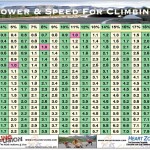If you live in a state that is relatively flat (3% grade or less on most roads), then generating power will be more for generating speed, overcoming wind resistance, toning leg muscles, and in general getting fitter. However, if you live in one of our hilly states, you know well that it”™s all about the climbing.
In fact, unless you are a time trial specialist, the main determining factor for whether you can be competitive in racing, or successful at that century ride you”™ve always dreamed of doing, will be how you ride in the hills. As a spectator of professional cycling, you may have also noticed that it is the mountain stages that typically determine who will make the podium, and who waits till the next race to make their mark. At the end of the day, climbing is just about the most important discipline to conquer in outdoor riding. To that end, the Cycling Fusion Speed & Power Climbing chart can help you train in the hills.
Across the top of the chart are the grades of a given climb. The left side represents the speed you will travel up the hill if you can generate the Watts/Lb that is reflected in the intersection of the two. For example, if you want to climb a 7% hill at 10 mph, you will need to generate 1.5 Watts/Lb. How do you know what grade a given hill is? There are numerous mapping programs that can tell you the average grade of a given section of road, you can get a reading from certain bike computers or GPS devices, or finally, you could calculate it if you know the elevation gain, distance and a little algebra.
Notice on the sample chart below, that the cells representing 1.0 or 1 Watt/lb are highlighted in red or pink. This is because the power created at this level permits the rider to climb most hills at a reasonable speed.

During the development of the Cycling Fusion Power Training System, we did numerous indoor and outdoor comparisons of power numbers, which included different victims (er volunteers) riding specific hills with specific grades and observing their average speed and power that was recorded from top to bottom. These field tests, as well as the general riding principles of the road provide the basis for 1 Watt/lb as the gateway to outdoor climbing. Consider also these facts:
- Below 5 mph, it is extremely difficult to keep a bike on line, rolling straight, safe and steady.
- Below 5% grade it”™s not much of a hill. As a point of reference, rail trails are typically 3% grade at their highest, and on occasions 4% because trains could not generally negotiate grades steeper than that.
- In looking at the top end of the applicable grades, research on road construction guidelines has shown us what we as avid cyclists already knew from experience, that double digit grades are rare, and construction crews avoid building roads that steep when possible, but there are times when that is not possible. There are a number of references on the internet that corroborate this fact; a couple appear below. Maine and New Hampshire each show guidelines that range from 5% to 12%:
- Consequently, the facts above permit us to construct a sort of minimum set of hill grades and speeds that should be manageable if one wants to ride outside, unimpeded. That is, the desire is to ride up each hill, not needing to get off and push the bike. This range is a speed starting at 5 mph, and a grade that can be negotiated up to 10% grade. The configuration below represents the minimum output required to keep riding within these guidelines. In general, it is 1 Watt/lb or less:

- Notice that 10% does not quite make the 1.0 Watt/Lb guideline. Since we know that double digit grades are more rare, and often of shorter length, we can assume that the rider can use power in their Climbing or Explosive zones to conquer these sections.
- Me & My Big Mouth - April 18, 2024
- Indoor Cycling Power Research #7: Good News, Bad News - August 16, 2023
- Blog Post #10 Baseline& Performance Testing - June 29, 2023
